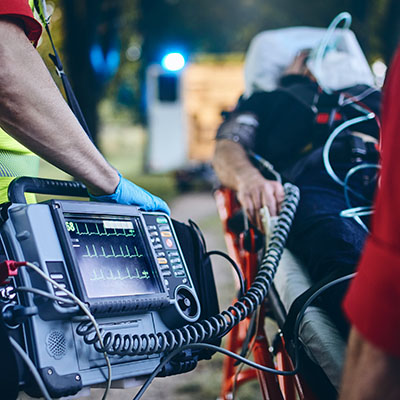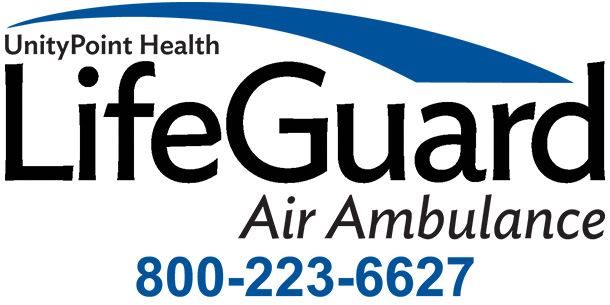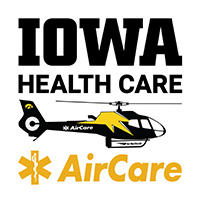15th Annual
Tri-State Emergency Responders Conference
Dubuque, IA

Save the Date
Join us for the 15th Annual Tri-State Emergency Responders Conference October 17-18, 2025. This year's conference will be held at the Diamond Jo Casino, directly across from the Grand River Center. We have an exciting lineup of sessions planned featuring nationally recognized presenters, CEH-approved presentations and a free exhibit hall highlighting the latest products and services in the field.
Conference Agenda
Check In
Exhibit Area Opens
EMS Tract Opens
Drowning on Dry Land: Heart Failure
Congestive heart failure (CHF) is a common disease process encountered in the field. Treatment for these patients can be complex, and they have a high potential to rapidly deteriorate. However, by understanding the pathophysiology of CHF, you can direct your treatment more specifically and effect clinical improvement before the patient is delivered to the hospital. This presentation begins with a review of the physiological processes of stroke volume, Starling's law of the heart, cardiac output, and ventricular ejection fraction. We will then discuss the pathophysiology and clinical presentations of left and right heart failure. Specific treatment modalities discussed include CPAP/BiPAP and nitroglycerin—the hallmarks of CHF treatment, as well as other BLS and ALS treatment strategies.

It's Not Your Mama's Ganga (High Dose THC)
The use of THC is on the rise, and it is critical that, as medical professionals we stay current with the multiple types and modalities of THC being used. With the legalization of THC and the constant research and development of new cannabinoids, it is essential for us to not only to understand how to treat an overdose but also understand the impact THC has on the human body. We will discuss the basics of THC, what it is, and where it came from, as well as explore the chemical derivatives of THC and subsequent detriments to the human body. In addition, we will explore both common and uncommon symptomatology, treatment approaches, and the pathophysiology of the different types of cannabinoids.

Don't Buy The Farm
"Green Acres" might be the place to be, but have you ever considered just how many hazards there are on the farm? Join Denell on a tour of the entire farm from pasture to grain bin, from barn to paddock, and explore all the ways your patients can "buy the farm" while on the farm.

Precious Cargo: Maternal Cardiac Arrest
The incidence of out-of-hospital maternal cardiac arrest (OOH-MCA) is 0.0018%, or 1.8 per 100,000 pregnant women, according to published literature. OOH-MCA may be an extremely low-frequency event, but it is of extremely high value and requires modification to resuscitation principles and practices. Are you and your agency psychologically and logistically prepared if such an event were to happen today? While the maternal mortality rate (MMR) has decreased and plateaued worldwide, it continues to increase in the U.S. This presentation begins with a review of the anatomic and physiologic adaptations to pregnancy and the relevance of those adaptations to your assessment and management of MCA. With a better understanding of what causes OOH-MCA, we are now better equipped to prevent this catastrophic event from occurring. Procedural modifications for OOH-MCA will then be discussed, along with the latest evidence-based resuscitation guidelines and the most suitable transport destinations.

Breakfast With Tiffany
Hold on to your Ovaltine and your grippy socks! Tiffany Varjack is 88 and full of life…. And full of gossip! She is all up in everyone's business at Moon River Assisted Living, and she's spilling everything she knows and everything "Doc" tells her. It's like a soap opera in the nursing home! Injury- check. Romance- check. Scandal- check! Rising from the dead- well, maybe not quite like a soap opera. Come have breakfast with Tiffany and hear all the latest gossip in this geriatric course built around the characters from the 1939 classic film, and enjoy the not-so-classic presentation format. Beware, though, Tiffany is pretty spry for an old gal!

Airway Management: The Anatomy, Physiology, and Procedure
Do you measure your success at airway management on whether you "get the tube," or do you measure it by how well you keep the patient oxygenated and ventilated? The techniques to achieve effective oxygenation and ventilation vary, but the end game does not (and cannot). This presentation begins with a review of key airway anatomy utilizing high-resolution cadaveric images. You will see exactly where your simple airway adjuncts and supraglottic airways, when properly placed, sit in the airway, which may give you a better understanding of how they work and how effective they can be. Sure, we'll discuss good intubation technique, but not before resetting the concepts of foundational airway management in our minds. We will then review the physiology of ventilation to appreciate that breathing does more than just move air into and out of our lungs. Have you ever been ventilating a patient and trashed their blood pressure? After this discussion, you'll understand why this happened, as well as how it could have been prevented. Bottom line: if you deliver a well-oxygenated and ventilated patient to the emergency department, regardless of how you achieved it, your patient wins every time. On the other hand, if you deliver a hypoxemic, hypotensive patient…well, you can see where that train will go.

Handbook for the Recently Deceased
Medical Director. Medical Director. Medical Director! No, you cannot simply say it three times and have it magically appear. In the interim, we need to know how to talk to our patients and their families about death, dying, power of attorney, DNRs, and all the legal jargon surrounding them. Sure, it's super scary to think about having to have those conversations with your patient, but you might be surprised at how comforting you can be for these patients and their families when you are comfortable with your words. Avoiding the "sandworms" of saying the wrong things when dealing with delicate situations and facing the harsh reality of having to use the word "dead" can sometimes be overwhelming, but this handbook will provide you with some tips for navigating the aftermath for your patient's best interest. Sometimes, though, the only thing left to do is summon the all-powerful and ask for their help. They're not as scary as we think. Say it with me... Medical Director. Medical Director. Medical Director!

Heads Up! Traumatic Brain Injury
Traumatic brain injury (TBI) is a major cause of death and disability following trauma. Actions taken by EMS providers, regardless of their level of training, have a direct impact on patient outcomes. This presentation is geared towards all levels of EMS providers. It begins with a discussion of cerebral perfusion, the normal physiologic processes the body employs to maintain it, and how the body responds to increased intracranial pressure— knowledge that is crucial to understanding why some prehospital interventions are performed and why others are (and should be) avoided. The potentially disastrous effects of secondary brain injury, and how to minimize or avoid them, are discussed in detail. Specific injuries discussed include subdural and epidural hemorrhage (focal injuries), axonal injury (diffuse injury), and intracerebral hemorrhage; this includes clinical presentations, critical assessment parameters, and key emergency care procedures and interventions. We will also review the latest scientific literature on the use of TXA for TBI patients, as well as the effects of hard cervical collars on intracranial pressure.

Day 1 Wrap Up & Exhibit Area Closes
Entertainment at the Mississippi Moon Bar
Check In
EMS Tract Opens
Pediatric Cardiac Arrest: Doing Right by Our Children
Nationally, less than 1 out of 10 children who experience out-of-hospital cardiac arrest survive, a statistic that has remained unchanged for the last 15 years. However, there has been a consistent increase in survival over that same period when the child’s cardiac arrest occurs in the hospital. Why is this, and what can we do to give our children a better chance? This presentation reviews the pathophysiology of pediatric cardiac arrest, with a focus on pediatric assessment and recognition of the child who is in a peri-arrest situation. We will then examine current and future trends in pediatric resuscitation, from Basic Life Support (BLS) to Advanced Life Support (ALS). By employing specific strategies (which also involve a change in mindset), agencies across the country are demonstrating a marked improvement in survival. Compared to adults, you will undoubtedly encounter fewer pediatric cardiac arrests per year in your agency. However, when they do occur, do you have a resuscitation plan? If not, why not? If so, do you practice it? Let’s challenge ourselves to turn the tide in pediatric cardiac arrest survival!

Saved By the Bell
When you wake up in the mornin' and the pager gives out warnin' you don't think you'll ever make it on time... By the time you grab your "ears" and you shake off all your fears you're at the station just in time to see the 'bulance fly by. But it's alright.. we are going to cover all the things lurking in the school, including things we don't think of as a school emergency. Playground accidents, medical emergencies, and many more "subjects" will be covered in this A+ class. Kid calls bring out the nervousness in all of us, and the idea of natural disasters or school shooters definitely up the stress level. Join Denell for a school tour that will leave you prepared and ready... and saved by the bell!

Final Option for a Bad Situation: Surgical Airways Access Realities
The pathway to mitigation of a true “can’t intubate, can’t oxygenate” situation is very short and very direct—a cricothyrotomy. Emergent surgical airway access via the cricothyroid membrane is a procedure that many paramedics will never perform in their career; are YOU the next one who will be faced with this task? The low-frequency, high-risk nature of this skill mandates absolute knowledge of the anatomy of the anterior neck, frequent practice, and procedural confidence. When cricothyrotomy fails, it is often due to an inability to locate the anatomic structures of the larynx properly. This presentation delves into the realities of cricothyrotomy in a manner that you have likely never encountered before. Utilizing high-resolution cadaveric images, the anterior neck will be procedurally dissected, and critical anatomic structures will be identified. A step-by-step approach, based on the latest evidence and best practices, will be followed to maximize your success in performing this time-sensitive, final option procedure. No patient should go to the morgue (for lack of an airway) without a hole in their neck!

Strokes: Why the Long Face?
Strokes are encountered often in EMS, but are we doing it right? With new treatments and protocols being developed every day, it is essential to review current research. Looking beyond standard protocols, evidence-based research provides innovative approaches to stroke assessment that may allow better in field and accepting facility reaction times leading to better patient outcomes. As we examine small but meaningful assessment changes, we can start to understand the level of care our patient needs. This is a review of anatomy, physiology, and pathophysiology and the role they play in determining new standards of care.

Birthin' Babies
Lawdy, we needs a doctor. I don't know nuthin' bout birthin' babies, Miss Scarlet! We all feel that way when we get toned out to a potential labor and delivery call. Frankly, my dear, it's not that complicated as long as it's not... well, complicated. Boil some water. Fetch some blankets. Catch! Ok, so maybe it's not that simple, but if you want to cover some of the most common and life-threatening possibilities of in-the-field childbirth as well as how to manage the delivery of the nugget of joy then this is the class for you! By the time this class ends, you can tell Miss Scarlett you know all the things bout birthin' babies.

Don’t Let Your Scene Turn Into a Jerry Springer Show!!
This is a look at behavioral incidents. Often, we in EMS find ourselves walking into situations where we may be putting ourselves in danger. The concept of scene safety is extremely important, but what do we do when a scene changes and there is no way out immediately? This is a class to discuss all the things that take our safe everyday scenes and turn them into a clip for the Jerry Springer show.

OH CRAP: Out of Hospital Critical Respiratory and Airway Problems
Uh, oh! Few things are as acute and rapidly evolving as true respiratory emergencies. The question is- can you keep up, or will you find yourself out of breath at the finish line? Let’s discuss some common and not-so-common respiratory emergencies and their treatment as you inhale some fun knowledge and exhale all your fears surrounding taking care of respiratory patients! Come on in, the air’s fine in here.

Working the Beat: Become a Cardiac Sleuth!
This is a comprehensive look at everything from the start of a cardiac emergency all the way to the choice between PCI (percutaneous coronary intervention) versus medications or supportive care. Recent studies have shown that we are missing 18-40% of all patients who should be receiving PCI treatment. We, as EMS, can help advocate for this on behalf of our patients and improve our outcomes. This class requires you to know how to read a 12-lead at least at a basic ALS provider, as we will be reviewing some of the imposters and trip hazards we encounter as providers.

Day 2 Wrap Up
Entertainment at the Mississippi Moon Bar
With an esteemed career that includes and sharing stages with giants like The Rolling Stones, Eric Clapton, SLASH, Kenny Wayne Shepherd, and Eric Johnson on the legendary Experience Hendrix Tour, Samantha Fish offers a concert experience unlike any other. Prepare to be captivated by one of the most formidable guitarists of her generation as Samantha Fish embarks on her 2025 Paper Doll Tour. Samatha and her all-star band bring a relentless energy and emotional depth to every stage they grace. Following her multi-award-winning success and a Grammy-nominated album, *Death Wish Blues*, in collaboration with rocker Jesse Dayton, which soared to #1 on the Billboard Blues Chart, Samantha Fish is back with her new album, *Paper Doll*. The album's nine powerful tracks that come alive on the Paper Doll Tour along with fan favorites. Join Samantha Fish on the Paper Doll Tour for an electrifying night of masterful guitar work, raw soul, and songs that resonate deep within. Whether you're a lifelong fan or new to her music, Samantha Fish is sure to leave you awestruck with her passionate performance and undeniable talent.
Purchase Tickets (not included in conference price)

Registration Options
One-Day Conference
- Choose Your Day
- Up to 8 CEHs
Accommodations
Grand Harbor Hotel
Phone: 563.690.4000 ext. 1
Rate: $129/night
Reserve by: September 17
Call and identify yourself as NICC Fire/EMS Conference or NICC Firefighters.
Hotel Julien
Phone: 1.800.798.7098
Rate: $179-189/night
Reserve by: September 16
Identify with block name Tri-State Emergency Responders Conference.
Holiday Inn Dubuque
Phone: 563.556.2000
Rate: $169/night
Reserve by: September 16
Identify with block name NICC Tri-State Emergency Responder.
Join the Mailing List
Sign up to receive the latest information on this year's conference and details on future conferences.









